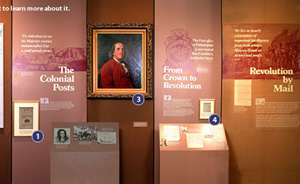talking history | syllabi | students | teachers | puzzle | about us
National Postal Museum
http://www.postalmuseum.si.edu
Created and maintained by the National Postal Museum, Washington, D.C.
Reviewed Dec. 10, 2005.
The National Postal Museum’s Web site will appeal to a diverse audience of historians, educators, stamp collectors, and the interested public. The online exhibitions and supplementary reference material cover virtually every aspect of postal history from stamp-making methods to the history of airmail. The Web site is attractively designed and easy to navigate.

“Binding the Nation,” one of the site’s permanent exhibits.
The heart of the site is the Exhibits section, containing summaries of six permanent and four temporary exhibitions on display in the museum and eleven online exhibitions. The permanent exhibits, such as “Binding the Nation” and “Moving the Mail,” provide an excellent overview of the history of the mail service from Benjamin Franklin’s era to today. The temporary and online exhibits are less general in scope. They cover much more specific topics, such as the Klondike gold rush and stamps commemorating the baseball hall-of-famer Roberto Clemente.
Educators will find useful material as well. The section for educators has two parts. The first provides three guided tour options for visits to the museum with connections to curriculum standards for the District of Columbia, Maryland, and Virginia. The second part contains five curriculum guides suitable for use for elementary, middle, and high school students. Some guides, such as “We Were There: Letters from the Battle Front” for high school students and “Letters from Home” for students of English as a second language, have the potential to work well in the hands of a skilled teacher. It is more difficult to see how other guides, such as “Stamp Mural Mosaics,” which tell how to use canceled stamps to create art projects, can be used in classrooms.
A promising way to provide educational content is through National History Day. This Web site provides several topics and matching resources for this year’s theme: “Taking a Stand in History.” Ideas for projects include the formation of a union by black railway mail workers in 1913, rural reformers' campaign for free rural delivery, and the intersection between the mail and such issues as abolition and freedom of expression. The site provides a “Strategies and Methods” section as well as a compilation of suggested sources for further research. The material here should inspire many successful National History Day projects.
This Web site skillfully combines objects, explanatory text, and references for later consultation. It is laid out well, with main navigation links to the left of the exhibit display and links for related information to the right. Links to related topics open in a new window so that the user does not lose his place within the exhibit. The Web site’s design has drawbacks, however. Some links take the user to an older version of the Web site, with different graphics and layout; this transition is jarring. Navigation within exhibits is good, but that between exhibits is difficult. Also, some portions of the site require high-speed Internet capability.
This is an ambitious Web site that achieves a number of objectives. It provides users an overview of the museum’s physical exhibits, presents new exhibits online, and helps teachers develop classroom content. Overall, this is a well-designed site that appeals to a diverse audience.
David Hochfelder
Edison Papers
Rutgers University
New Brunswick, New Jersey
